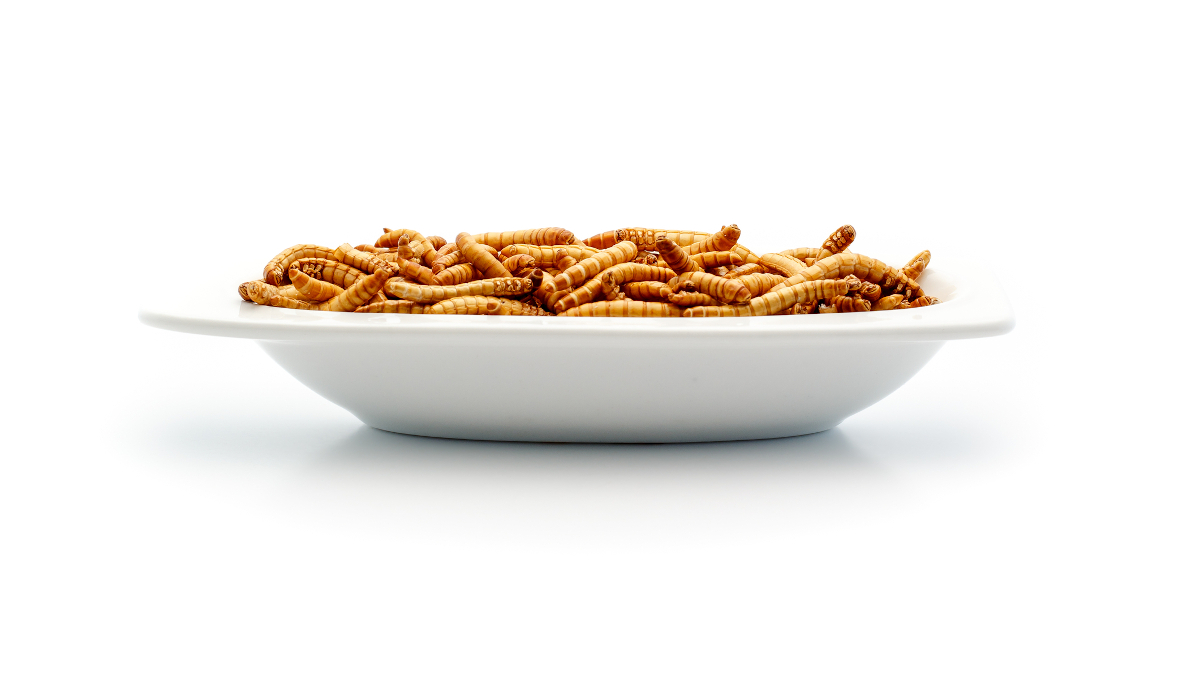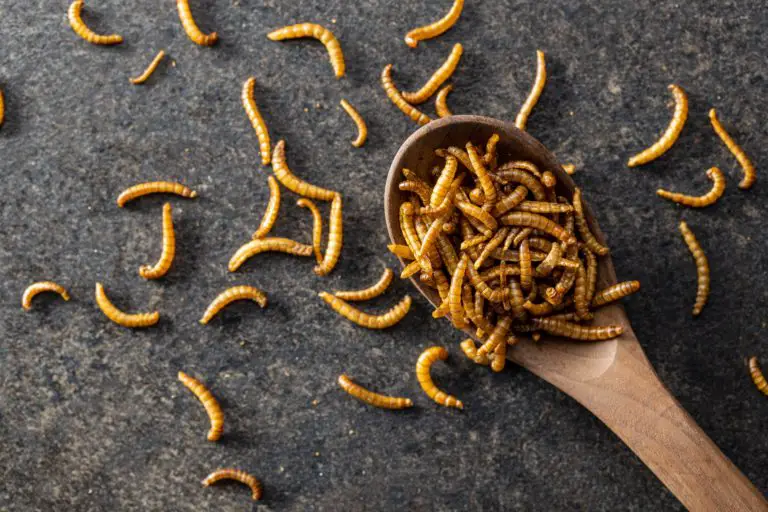The future of food may be taking a surprising twist, thanks to an unlikely source – mealworms. These unassuming insects are now emerging as a potential solution to address the growing demand for sustainable protein sources while offering a unique culinary experience. Their ability to provide a “meat-like” flavor and a rich source of nutrients has intrigued researchers and chefs alike, sparking discussions about whether mealworms could become a staple in our diets. In this article, we’ll explore the fascinating world of mealworms and their potential to revolutionize the way we think about food.

Mealworms: A Promising Meat Alternative?
Mealworms, the yellow-brown beetle larvae commonly found in the pet aisle as bird, fish, or reptile feed, might not initially strike you as a delectable food option. However, these little critters are packed with protein and could potentially serve as a sustainable meat alternative for humans as well. Scientists at Wonkwang University in South Korea have even found a way to enhance their flavor by cooking them with sugar, resulting in a more appetizing and “meat-like” taste. The team presented their findings at the fall meeting of the American Chemical Society.
Exploring New Food Sources
With the global food market continuously expanding and natural food resources depleting, the exploration of new food materials is of utmost importance. While the idea of eating insects may seem novel to some, many cultures around the world have been consuming and selling insects in street food and markets for centuries. In fact, as early as 2013, the Food and Agriculture Organization of the United Nations (FAO) suggested that insects should be considered a future food resource to meet rising global consumer demands.
South Korea, for instance, has already accepted 10 insects as food ingredients, and in 2014, mealworms were added to this list. More recently, in 2021, mealworms were also approved for consumption in the European Union.
Improving the Flavor Profile of Mealworms
While mealworms have received approval for consumption, their unappetizing physical appearance often deters potential consumers. To address this issue, scientists at Wonkwang University delved into ways to make mealworms more appealing to the palate. Their research focused on exploring the volatile compositions of mealworms at different stages of their life cycle to enhance their flavor profile.
During their investigations, the researchers discovered that the various stages of the mealworm life cycle emitted specific scents when volatile hydrocarbons evaporated. For example, raw larvae produced scents reminiscent of sweet corn, shrimp, and wet soil.

The scientists then examined how these aromas changed during different cooking methods. They found that roasted and deep-fried larvae exhibited attributes similar to shrimp and fried oil, while steamed larvae emitted a stronger sweet corn aroma.
What set this study apart was the addition of extra flavors to the cooking process. By incorporating garlic powder, amino acids, mushroom powder, onion powder, and sugar into the cooking methods, the researchers achieved a “meat-like” and savory flavor in the mealworms.
Further investigation involved testing different ratios and manufacturing conditions of powdered mealworms and sugars. The researchers identified a total of 98 volatile compounds and used a panel of volunteers to determine the combinations that resulted in the most favorable “meat-like” odor.
Hyeyoung Park, a member of the research team, stated, “As a result of this study, 10 of the reaction flavors were optimized based on consumer preferences.“
The researchers hope that their findings will encourage more consumers to embrace insect-based foods. Moving forward, they aim to refine the process further and either eliminate or harness the remaining shrimp-like flavor profile. The latter could potentially lead to the utilization of mealworms as a seafood alternative.
The Benefits of Eating Insects
The consumption of insects offers several advantages over traditional livestock farming. Insect farming requires significantly less land, water, and feed compared to traditional livestock. Additionally, insects are highly nutritious and contain ample amounts of fatty acids, vitamins, minerals, fiber, and high-quality protein that closely resemble those found in meat.
Dr. In Hee Cho, the principal investigator of the project, notes, “Recently, eating insects has become of interest because of the increasing cost of animal protein, as well as the associated environmental issues.“
Embracing Insect-Based Meals: Culinary Adventures with Mealworms
The idea of cooking with mealworms might initially evoke a sense of trepidation, but it’s essential to remember that these tiny creatures are not only a sustainable source of nutrition but also versatile ingredients that can elevate your culinary creations. Here, we delve deeper into the world of mealworms and offer some creative tips on incorporating them into your meals.
1. A Meaty Alternative: One of the most exciting aspects of mealworms is their potential to replace meat in your favorite recipes. Whether you’re crafting a hearty stir-fry, savory tacos, or a comforting pasta dish, mealworms can step in as a unique and nutritious meat substitute. Their slightly nutty flavor and satisfying texture can enhance the overall taste and nutritional value of your meals.
2. Culinary Alchemy: To fully appreciate mealworms, consider roasting or frying them with an array of spices and seasonings. By experimenting with different flavor profiles, you can unlock a world of taste possibilities. From savory and spicy to sweet and tangy, the versatility of mealworms means you can adapt them to suit a wide range of dishes, catering to your personal preferences.
3. Nutrient-Rich Boost: For those seeking an extra dose of nutrition in their daily routine, mealworms can seamlessly blend into your morning smoothies or post-workout protein shakes. Their neutral taste won’t overpower your beverage, but their protein, healthy fats, and essential vitamins and minerals will certainly boost your overall nutrition.
4. Baking Innovations: Think outside the box by grinding mealworms into a fine powder and incorporating them into your baking endeavors. This protein-rich ingredient can enrich your bread, pancakes, or energy bars with added nutritional value. It’s a fantastic way to sneak in an extra layer of sustenance without compromising on flavor.
5. Ready-Made Options: If you’re not quite ready to embark on your mealworm culinary journey, you’ll be pleased to know that there’s a growing market for mealworm-based snacks and treats. From mealworm protein bars that offer a convenient, on-the-go source of energy to roasted mealworms infused with unique and delightful flavors, these options allow you to dip your toes into the world of insect-based foods without the need for culinary experimentation.
As more people become aware of the benefits of insect-based foods, including mealworms, there is a growing demand for innovative and sustainable food options. Embracing mealworms as a regular part of our diets can contribute to reducing our environmental impact and improving our health.
Insect Cuisine: Pioneering Sustainable Eating
The journey toward a more sustainable and planet-friendly food culture is filled with exciting opportunities, and mealworms are just the beginning. As we continue to explore alternative protein sources and innovative culinary practices, we not only reduce our environmental footprint but also open the door to a world of flavors and possibilities.
So, why not take a bold step and give mealworms a try? Embracing insect cuisine isn’t just about sustainability; it’s about broadening our culinary horizons, nourishing our bodies with nutrient-rich foods, and joining the global movement towards a greener, healthier future. As you venture into this uncharted territory of sustainable eating, you might just discover a newfound appreciation for these tiny creatures with a big role in shaping the future of food. Bon appétit!

This Site Was Inspired By An Interest in Protecting the Environment:
We had the privilege and joy of learning from Dr. Charlie Stine who instilled a love for the natural world through incredible field trips with the Johns Hopkins Odyssey Certificate program in Environmental Studies. At the time, the program was endorsed by the Maryland Department of Natural Resources. Sadly, after Dr. Stine retired, the program was phased out. We hope that we honor his legacy by shining a bright light on environmental issues and sharing good news about the success of various conservation programs when possible.


